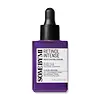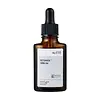What's inside
What's inside
 Key Ingredients
Key Ingredients

 Benefits
Benefits

 Concerns
Concerns

 Ingredients Side-by-side
Ingredients Side-by-side

Water
Skin ConditioningCyclohexasiloxane
EmollientDicaprylyl Carbonate
EmollientGlycerin
HumectantMethylpropanediol
Solvent1,2-Hexanediol
Skin ConditioningNiacinamide
SmoothingHydrogenated Poly(C6-14 Olefin)
EmollientPanthenol
Skin ConditioningTocopheryl Acetate
AntioxidantPiper Methysticum Leaf/Root/Stem Extract
Skin ConditioningCentella Asiatica Extract
CleansingPanax Ginseng Berry Extract
Skin ConditioningGlycyrrhiza Glabra Root Extract
BleachingFicus Carica Fruit Extract
HumectantCentella Asiatica Leaf Extract
Skin ConditioningCentella Asiatica Root Extract
Skin ConditioningMelaleuca Alternifolia Leaf Extract
PerfumingArtemisia Capillaris Extract
Eclipta Prostrata Extract
Skin ConditioningMelia Azadirachta Leaf Extract
Skin ConditioningElaeis Guineensis Oil
EmollientHydrogenated Lecithin
EmulsifyingGlyceryl Stearate
EmollientBakuchiol
AntimicrobialPalmitic Acid
EmollientSodium Polyacrylate
AbsorbentStearic Acid
CleansingXanthan Gum
EmulsifyingRetinol 0.1%
Skin ConditioningAcrylates/C10-30 Alkyl Acrylate Crosspolymer
Emulsion StabilisingButylene Glycol
HumectantDipotassium Glycyrrhizate
HumectantAdenosine
Skin ConditioningTromethamine
BufferingPolyquaternium-51
Skin ConditioningBeta-Glucan
Skin ConditioningCetyl Alcohol
EmollientBHT
AntioxidantCollagen
MoisturisingMyristic Acid
CleansingBHA
AntioxidantLeuconostoc/Radish Root Ferment Filtrate
AntimicrobialTocopherol
AntioxidantBifida Ferment Lysate
Skin ConditioningCeramide NP
Skin ConditioningSaccharomyces Ferment
Skin ConditioningRetinal
Skin ConditioningAsiaticoside
AntioxidantGlyceryl Polymethacrylate
Madecassoside
AntioxidantPropylene Glycol
HumectantPolyglyceryl-10 Oleate
Skin ConditioningGlycolipids
Skin ConditioningGlycine Soja Peptide
Skin ConditioningResveratrol
AntioxidantSucrose Distearate
EmollientAsiatic Acid
Skin ConditioningMadecassic Acid
Skin ConditioningPalmitoyl Tripeptide-1
Skin ConditioningMoringa Oleifera Seed Oil
EmollientPEG-100 Stearate
Polysorbate 20
EmulsifyingParfum
MaskingEthylhexylglycerin
Skin ConditioningWater, Cyclohexasiloxane, Dicaprylyl Carbonate, Glycerin, Methylpropanediol, 1,2-Hexanediol, Niacinamide, Hydrogenated Poly(C6-14 Olefin), Panthenol, Tocopheryl Acetate, Piper Methysticum Leaf/Root/Stem Extract, Centella Asiatica Extract, Panax Ginseng Berry Extract, Glycyrrhiza Glabra Root Extract, Ficus Carica Fruit Extract, Centella Asiatica Leaf Extract, Centella Asiatica Root Extract, Melaleuca Alternifolia Leaf Extract, Artemisia Capillaris Extract, Eclipta Prostrata Extract, Melia Azadirachta Leaf Extract, Elaeis Guineensis Oil, Hydrogenated Lecithin, Glyceryl Stearate, Bakuchiol, Palmitic Acid, Sodium Polyacrylate, Stearic Acid, Xanthan Gum, Retinol 0.1%, Acrylates/C10-30 Alkyl Acrylate Crosspolymer, Butylene Glycol, Dipotassium Glycyrrhizate, Adenosine, Tromethamine, Polyquaternium-51, Beta-Glucan, Cetyl Alcohol, BHT, Collagen, Myristic Acid, BHA, Leuconostoc/Radish Root Ferment Filtrate, Tocopherol, Bifida Ferment Lysate, Ceramide NP, Saccharomyces Ferment, Retinal, Asiaticoside, Glyceryl Polymethacrylate, Madecassoside, Propylene Glycol, Polyglyceryl-10 Oleate, Glycolipids, Glycine Soja Peptide, Resveratrol, Sucrose Distearate, Asiatic Acid, Madecassic Acid, Palmitoyl Tripeptide-1, Moringa Oleifera Seed Oil, PEG-100 Stearate, Polysorbate 20, Parfum, Ethylhexylglycerin
Water
Skin ConditioningGlycerin
HumectantPropanediol
SolventPentylene Glycol
Skin ConditioningRetinol
Skin ConditioningHydroxypinacolone Retinoate
Skin ConditioningTocopheryl Retinoate
AntioxidantRetinyl Palmitate
Skin ConditioningHydrogenated Retinol
Skin ConditioningSodium Retinoyl Hyaluronate
Hydrogenated Lecithin
EmulsifyingSodium Acetylated Hyaluronate
HumectantSodium Hyaluronate Crosspolymer-2
HumectantHydrolyzed Sodium Hyaluronate
Skin ConditioningSodium Hyaluronate
HumectantArachis Hypogaea Oil
Skin ConditioningCaprylic/Capric Triglyceride
MaskingCentella Asiatica Extract
CleansingScutellaria Baicalensis Root Extract
AstringentPolygonum Cuspidatum Root Extract
AntioxidantGlycyrrhiza Glabra Root Extract
BleachingCamellia Sinensis Leaf Extract
AntimicrobialRosmarinus Officinalis Leaf Extract
AntimicrobialChamomilla Recutita Flower Extract
MaskingXanthan Gum
EmulsifyingButylene Glycol
HumectantEthylhexylglycerin
Skin ConditioningTocopherol
AntioxidantPolysorbate 20
EmulsifyingCarbomer
Emulsion StabilisingPotassium Hydroxide
BufferingCalcium Sodium Borosilicate
Silver Oxide
AntimicrobialWater, Glycerin, Propanediol, Pentylene Glycol, Retinol, Hydroxypinacolone Retinoate, Tocopheryl Retinoate, Retinyl Palmitate, Hydrogenated Retinol, Sodium Retinoyl Hyaluronate, Hydrogenated Lecithin, Sodium Acetylated Hyaluronate, Sodium Hyaluronate Crosspolymer-2, Hydrolyzed Sodium Hyaluronate, Sodium Hyaluronate, Arachis Hypogaea Oil, Caprylic/Capric Triglyceride, Centella Asiatica Extract, Scutellaria Baicalensis Root Extract, Polygonum Cuspidatum Root Extract, Glycyrrhiza Glabra Root Extract, Camellia Sinensis Leaf Extract, Rosmarinus Officinalis Leaf Extract, Chamomilla Recutita Flower Extract, Xanthan Gum, Butylene Glycol, Ethylhexylglycerin, Tocopherol, Polysorbate 20, Carbomer, Potassium Hydroxide, Calcium Sodium Borosilicate, Silver Oxide
 Reviews
Reviews

Ingredients Explained
These ingredients are found in both products.
Ingredients higher up in an ingredient list are typically present in a larger amount.
Butylene Glycol (or BG) is used within cosmetic products for a few different reasons:
Overall, Butylene Glycol is a safe and well-rounded ingredient that works well with other ingredients.
Though this ingredient works well with most skin types, some people with sensitive skin may experience a reaction such as allergic rashes, closed comedones, or itchiness.
Learn more about Butylene GlycolCentella Asiatica Extract (Centella) is derived from an herb native to Southeast Asia. It is famous for its anti-inflammatory and soothing properties.
Centella is rich in antioxidants and amino acids, such as Madecassic Acid and Asiaticoside.
Studies show the compounds in centella help with:
The combination of all these properties makes centella effective at soothing, hydrating, and protecting the skin.
Other great components of centella include Vitamin A, vitamin C, several B vitamins, and Asiatic Acid.
Fun fact: Centella has been used as a medicine and in food for many centuries. As a medicine, it is used to treat burns, scratches, and wounds.
Learn more about Centella Asiatica ExtractEthylhexylglycerin (we can't pronounce this either) is commonly used as a preservative and skin softener. It is derived from glyceryl.
You might see Ethylhexylglycerin often paired with other preservatives such as phenoxyethanol. Ethylhexylglycerin has been found to increase the effectiveness of these other preservatives.
Glycerin is already naturally found in your skin. It helps moisturize and protect your skin.
A study from 2016 found glycerin to be more effective as a humectant than AHAs and hyaluronic acid.
As a humectant, it helps the skin stay hydrated by pulling moisture to your skin. The low molecular weight of glycerin allows it to pull moisture into the deeper layers of your skin.
Hydrated skin improves your skin barrier; Your skin barrier helps protect against irritants and bacteria.
Glycerin has also been found to have antimicrobial and antiviral properties. Due to these properties, glycerin is often used in wound and burn treatments.
In cosmetics, glycerin is usually derived from plants such as soybean or palm. However, it can also be sourced from animals, such as tallow or animal fat.
This ingredient is organic, colorless, odorless, and non-toxic.
Glycerin is the name for this ingredient in American English. British English uses Glycerol/Glycerine.
Learn more about GlycerinGlycyrrhiza Glabra Root Extract is an extract of the roots of Licorice. It has been found to have several benefits such as skin hydrating, conditioning, and soothing.
One component, glabridin, has extra potent antioxidant and soothing properties. It has also been found to block pigmentation from UVB rays in guinea pigs.
Licorice Root also contains a flavonoid. Flavonoids are a natural substance from in plants. Flavonoids also have antioxidant properties.
Another component, glycyrrhizin, has been found to have anti-inflammatory and antimicrobial benefits. This may make licorice root extract effective at treating acne. However, more research is needed to support this.
Liquiritin is one of the flavone compounds found in licorice. It has been found to help lighten skin by preventing tyrosinase from reacting with tyrosine. When the two react, protein is converted to melanin. Melanin is the substance in your body that gives your features pigmentation.
Learn more about Glycyrrhiza Glabra Root ExtractHydrogenated Lecithin is created from the hydrogenation of lecithin (a group of phospholipids). Hydrogenation is a chemical reaction between hydrogen and another element.
This ingredient is an emollient and emulsifier. As an emollient, it helps soften skin by trapping moisture within. As an emulsifier, it prevents oil and water ingredients from separating.
Polysorbate 20 is made by combining ethoxylation of sorbitan, ethylene oxide, and lauric acid. It is a mild cleansing agent, surfactant, and emulsifier.
As a surfactant, it helps collect dirt and oils for washing. Emulsifiers prevent oils and water from separating.
Polysorbate 20 also adds scent to a product. Since it is made using sorbitol, it has a sweet scent. Sorbitol can also be found in fruits such as apples and peaches.
The lauric acid used to create Polysorbate 20 is often derived from coconuts.
Polysorbate 20 may not be fungal acne safe.
Learn more about Polysorbate 20Retinol is a gold-standard ingredient for anti-aging. It is a form of Vitamin A and belongs to the class of retinoids that also includes tretinoin.
Why is retinol famous?
It has the most scientific studies backing up its skin benefits out of all the non-prescription ingredients.
Retinol is proven to:
This is why retinol is effective at removing wrinkles, fading dark spots, treating acne, and reducing the appearance of pores.
Studies show retinol is less effective when exposed to UV. Be sure to look for appropriate packaging to keep your retinol potent (similar to Vitamin C).
Using retinol or any retinoids will increase sun-sensitivity in the first few months. Though studies show retinoids increase your skin's natural SPF with continuous use, it is best to always wear sunscreen and sun-protection.
We recommend speaking with a medical professional about using this ingredient during pregnancy.
Retinol may cause irritation in some people, so be sure to patch test. Experts recommend 'ramping up' retinol use: start using this ingredient once a week and work up to using it daily.
Read about Tretinoin
Learn more about RetinolTocopherol (also known as Vitamin E) is a common antioxidant used to help protect the skin from free-radicals and strengthen the skin barrier. It's also fat soluble - this means our skin is great at absorbing it.
Vitamin E also helps keep your natural skin lipids healthy. Your lipid skin barrier naturally consists of lipids, ceramides, and fatty acids. Vitamin E offers extra protection for your skin’s lipid barrier, keeping your skin healthy and nourished.
Another benefit is a bit of UV protection. Vitamin E helps reduce the damage caused by UVB rays. (It should not replace your sunscreen). Combining it with Vitamin C can decrease sunburned cells and hyperpigmentation after UV exposure.
You might have noticed Vitamin E + C often paired together. This is because it is great at stabilizing Vitamin C. Using the two together helps increase the effectiveness of both ingredients.
There are often claims that Vitamin E can reduce/prevent scarring, but these claims haven't been confirmed by scientific research.
Learn more about TocopherolWater. It's the most common cosmetic ingredient of all. You'll usually see it at the top of ingredient lists, meaning that it makes up the largest part of the product.
So why is it so popular? Water most often acts as a solvent - this means that it helps dissolve other ingredients into the formulation.
You'll also recognize water as that liquid we all need to stay alive. If you see this, drink a glass of water. Stay hydrated!
Learn more about WaterXanthan gum is used as a stabilizer and thickener within cosmetic products. It helps give products a sticky, thick feeling - preventing them from being too runny.
On the technical side of things, xanthan gum is a polysaccharide - a combination consisting of multiple sugar molecules bonded together.
Xanthan gum is a pretty common and great ingredient. It is a natural, non-toxic, non-irritating ingredient that is also commonly used in food products.
Learn more about Xanthan Gum